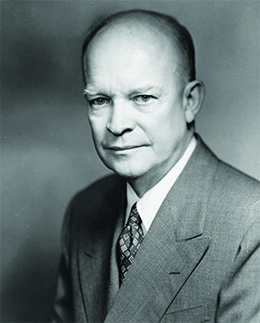| << Chapter < Page | Chapter >> Page > |
Against the backdrop of the Cold War, Americans dedicated themselves to building a peaceful and prosperous society after the deprivation and instability of the Great Depression and World War II. Dwight D. Eisenhower, the general who led the United States to victory in Europe in 1945, proved to be the perfect president for the new era. Lacking strong conservative positions, he steered a middle path between conservatism and liberalism, and presided over a peacetime decade of economic growth and social conformity. In foreign affairs, Eisenhower’s New Look policy simultaneously expanded the nation’s nuclear arsenal and prevented the expansion of the defense budget for conventional forces.
After Harry Truman declined to run again for the presidency, the election of 1952 emerged as a contest between the Democratic nominee, Illinois governor Adlai Stevenson, and Republican Dwight D. Eisenhower, who had directed American forces in Europe during World War II ( [link] ). Eisenhower campaigned largely on a promise to end the war in Korea, a conflict the public had grown weary of fighting. He also vowed to fight Communism both at home and abroad, a commitment he demonstrated by choosing as his running mate Richard M. Nixon, a congressman who had made a name for himself by pursuing Communists, notably former State Department employee and suspected Soviet agent Alger Hiss.

In 1952, Eisenhower supporters enthusiastically proclaimed “We Like Ike,” and Eisenhower defeated Stevenson by winning 54 percent of the popular vote and 87 percent of the electoral vote ( [link] ). When he assumed office in 1953, Eisenhower employed a leadership style he had developed during his years of military service. He was calm and willing to delegate authority regarding domestic affairs to his cabinet members, allowing him to focus his own efforts on foreign policy. Unlike many earlier presidents, such as Harry Truman, Eisenhower was largely nonpartisan and consistently sought a middle ground between liberalism and conservatism. He strove to balance the federal budget, which appealed to conservative Republicans, but retained much of the New Deal and even expanded Social Security. He maintained high levels of defense spending but, in his farewell speech in 1961, warned about the growth of the military-industrial complex , the matrix of relationships between officials in the Department of Defense and executives in the defense industry who all benefited from increases in defense spending. He disliked the tactics of Joseph McCarthy but did not oppose him directly, preferring to remain above the fray. He saw himself as a leader called upon to do his best for his country, not as a politician engaged in a contest for advantage over rivals.

Notification Switch
Would you like to follow the 'U.s. history' conversation and receive update notifications?